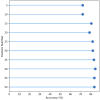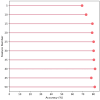Integrative Stacking Machine Learning Model for Small Cell Lung Cancer Prediction Using Metabolomics Profiling
- PMID: 39766124
- PMCID: PMC11727543
- DOI: 10.3390/cancers16244225
Integrative Stacking Machine Learning Model for Small Cell Lung Cancer Prediction Using Metabolomics Profiling
Abstract
Background: Small cell lung cancer (SCLC) is an extremely aggressive form of lung cancer, characterized by rapid progression and poor survival rates. Despite the importance of early diagnosis, the current diagnostic techniques are invasive and restricted. Methods: This study presents a novel stacking-based ensemble machine learning approach for classifying small cell lung cancer (SCLC) and non-small cell lung cancer (NSCLC) using metabolomics data. The analysis included 191 SCLC cases, 173 NSCLC cases, and 97 healthy controls. Feature selection techniques identified significant metabolites, with positive ions proving more relevant. Results: For multi-class classification (control, SCLC, NSCLC), the stacking ensemble achieved 85.03% accuracy and 92.47 AUC using Support Vector Machine (SVM). Binary classification (SCLC vs. NSCLC) further improved performance, with ExtraTreesClassifier reaching 88.19% accuracy and 92.65 AUC. SHapley Additive exPlanations (SHAP) analysis revealed key metabolites like benzoic acid, DL-lactate, and L-arginine as significant predictors. Conclusions: The stacking ensemble approach effectively leverages multiple classifiers to enhance overall predictive performance. The proposed model effectively captures the complementary strengths of different classifiers, enhancing the detection of SCLC and NSCLC. This work accentuates the potential of combining metabolomics with advanced machine learning for non-invasive early lung cancer subtype detection, offering an alternative to conventional biopsy methods.
Keywords: NSCLC; SCLC; machine learning; serum metabolomics; stacking ensemble model.
Conflict of interest statement
The authors declare that they have no competing interests.
Figures











Similar articles
-
Construction of a Diagnostic Model for Small Cell Lung Cancer Combining Metabolomics and Integrated Machine Learning.Oncologist. 2024 Mar 4;29(3):e392-e401. doi: 10.1093/oncolo/oyad261. Oncologist. 2024. PMID: 37706531 Free PMC article.
-
Non-invasive Prediction of Lymph Node Metastasis in NSCLC Using Clinical, Radiomics, and Deep Learning Features From 18F-FDG PET/CT Based on Interpretable Machine Learning.Acad Radiol. 2025 Mar;32(3):1645-1655. doi: 10.1016/j.acra.2024.11.037. Epub 2024 Dec 10. Acad Radiol. 2025. PMID: 39665892
-
Subclassification of lung adenocarcinoma through comprehensive multi-omics data to benefit survival outcomes.Comput Biol Chem. 2024 Oct;112:108150. doi: 10.1016/j.compbiolchem.2024.108150. Epub 2024 Jul 14. Comput Biol Chem. 2024. PMID: 39018587
-
Differentiating Peripherally-Located Small Cell Lung Cancer From Non-small Cell Lung Cancer Using a CT Radiomic Approach.Front Oncol. 2020 Apr 22;10:593. doi: 10.3389/fonc.2020.00593. eCollection 2020. Front Oncol. 2020. PMID: 32391274 Free PMC article.
-
Differentiating Small-Cell Lung Cancer From Non-Small-Cell Lung Cancer Brain Metastases Based on MRI Using Efficientnet and Transfer Learning Approach.Technol Cancer Res Treat. 2021 Jan-Dec;20:15330338211004919. doi: 10.1177/15330338211004919. Technol Cancer Res Treat. 2021. PMID: 34030542 Free PMC article.
References
Grants and funding
LinkOut - more resources
Full Text Sources

